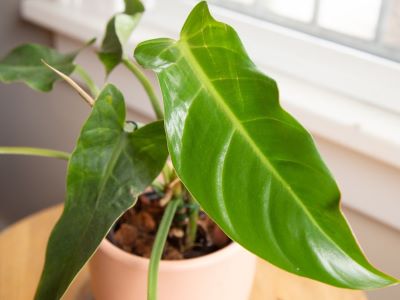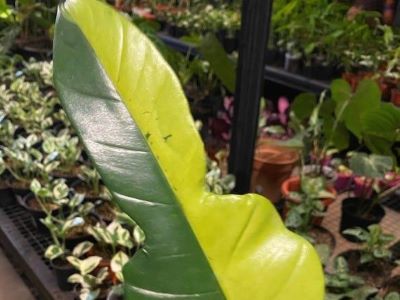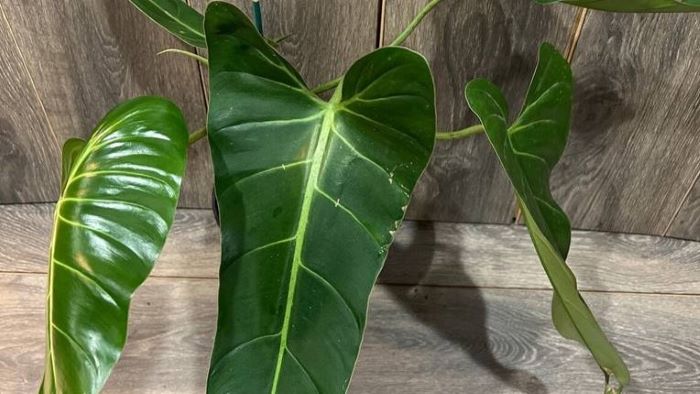Do you love plants with large, glossy, and arrow-shaped leaves that can climb or trail? If you answered yes, then you might want to consider the Philodendron Bernardopazii. This plant is native to the jungles of Brazil, where it grows as a hemiepiphyte, attaching itself to larger trees. It is not very common in cultivation, but it is highly sought after by aroid enthusiasts and collectors.
In this care guide, we will show you how to grow and care for this amazing plant. As well as how to propagate it and deal with any potential problems. If you are ready to add this beauty to your collection, keep reading and prepare to be amazed by the Philodendron Bernardopazii. 🌿
Read on to find out more about the Philodendron Bernardopazii and how to make it thrive in your home. 🌿
Contents
Essential Care Tips for Philodendron Bernardopazii
Philodendron Bernardopazii is a rare and stunning houseplant that originates from the Brazilian jungles. This plant has large, glossy, heart-shaped leaves that are bright green with white and red veins. Plus, it is also known as a climbing plant, which can grow up to two feet tall indoors, and up to 20 feet tall in its natural habitat. It is also relatively easy to care for, as long as you provide it with the right conditions.

For your better knowledge, we have jotted down some essential care tips for Philodendron bernardopazii, which will help you to take proper care of your plants.
1. Light
This plant has large, arrow-shaped leaves that can grow up to 18 inches wide. It comes from the tropical forests of Brazil, so it needs bright, indirect light for several hours a day. You can place it near a sunny window that is filtered by a sheer curtain or a blind, or use artificial lights to supplement the natural light. Be careful not to expose it to harsh afternoon sun that can damage its leaves.
You can tell if the plant is getting too much or too little light by looking at its leaves. The plant needs more light if they are leggy, pale, and slow-growing. On the other hand, if they have brown spots, yellow edges, or crispy texture, the plant needs less light. Also, you can adjust the light intensity by moving the plant closer or farther from the light source, or by changing the duration of the light exposure.
2. Soil
This tropical plant needs a rich, porous soil mix to thrive. You can make your own soil mix by combining indoor potting soil, perlite, and orchid bark mix in equal proportions. This will provide the plant with the nutrients, drainage, and aeration it needs. The soil pH should be slightly acidic to neutral, as this is the preferred range for most Philodendrons.
You can use a soil pH tester to measure the acidity level of your soil and adjust it with lime or sulfur if needed. The soil should be kept moist but not soggy, as overwatering can harm the plant’s roots and cause diseases.
3. Water
As we have an idea, to keep your plant healthy and happy, you should water it when the top half of the soil feels dry, or when the soil moisture meter reads in the dry zone. This may mean watering once or twice a week in the growing season, and once every two weeks in the dormant season.

Plus, you should water the plant thoroughly until the water drains out of the pot, and make sure the pot has drainage holes to avoid waterlogging. You should also use filtered or distilled water that is at room temperature or slightly warm, as tap water or cold water can damage the plant.
4. Temperature and Humidity
It is recommended to keep the plant in a room that has a consistent temperature between 65°F to 80°F (18°C to 27°C), and avoid exposing it to extreme cold or heat. You should also maintain a high humidity level around the plant by misting it regularly, using a humidifier, placing it on a pebble tray with water, or grouping it with other plants. This will help the plant stay hydrated and healthy.
5. Fertilizer
You should use a balanced, liquid fertilizer that is specially formulated for houseplants and dilute it to half or a quarter of the recommended strength. It is recommended to fertilize the plant once a month or once every two weeks during the spring and summer.
Note: You should apply the fertilizer after watering the plant thoroughly, to prevent salt buildup in the soil.
💭Know about monstera limp leaves! 💡Glacier pothos guide!
Types of Philodendron Bernardopazii
| Plant Type | Philodendron Plant Description |
| Standard Philodendron | The standard Philodendron Bernardopazii has large, glossy green leaves with white veins on the upper surface and red veins on the lower surface. It is a climbing plant that can reach up to 15 feet in height with support. |
| Narrow Form Philodendron | It has thinner and more elongated leaves than the standard type. Plus, it is also a climber that can grow up to 10 feet tall with support. |
| Superbum Philodendron | The superbum variety of Philodendron Bernardopazii is also known as Santa Leopoldina. It has wider and more rounded leaves than the standard type, with prominent white veins. It is a slower-growing plant that can reach up to 8 feet in height with support. |
Steps to Propagate Philodendron Bernardopazii
Propagation is the process of creating new plants from existing ones, either by using seeds, cuttings, or other methods. Philodendron Bernardopazii can be propagated by rooting stem cuttings, which is a relatively easy and reliable method. In the following section, we will show you the steps to propagate Philodendron Bernardopazii by stem cuttings.
Step 1: Take a Stem Cutting
- Choose a healthy and mature stem from your Philodendron Bernardopazii plant that has at least two nodes.
- Now, cut the stem about 1 inch below the last node by using scissors or pruning shears. But, make sure the cut is clean and smooth.
- Remove any lower leaves from the cutting, leaving only one or two leaves at the top.
- Then dip the cut end of the stem in a liquid rooting hormone if you have one. This will help the cutting develop roots faster.
Step 2: Place the Cutting in Water or Soil
- You can either place the cutting in a glass of water or a small pot with moist potting mix. Both methods work well, but water propagation is easier and faster.
- If you choose water propagation, fill a glass with water and insert the cutting in it. Make sure the node is submerged in water and the leaves are above the water level. Remember to change the water every few days to keep it fresh and prevent rotting.
- If you choose soil propagation, prepare a small pot with a well-draining potting mix. Make a hole in the center of the soil and insert the cutting in it. Then, gently press the soil around the cutting to secure it. Water the soil lightly to keep it moist but not soggy.
- Now, place the cutting in a warm and bright spot, but avoid direct sunlight. You can also cover the cutting with a plastic bag or a dome to create a humid environment.

Step 3: Wait for Roots to Develop
- It may take a few weeks for the cutting to develop roots. You can check the progress by gently tugging the cutting.
- Once the roots are about 2 inches long, you can transplant the cutting to a larger pot with fresh potting mix. You can also provide a moss pole or a trellis for the cutting to climb on as it grows.
Note: Water it regularly when the top inch of the soil feels dry. And prune any dead or damaged leaves as needed.
Common Problems With Philodendron Bernardopazii
Just like any other plant, this plant can also face some common problems that affect its health and appearance. For your reference, we have jotted down the most common issues you can notice in your philodendron plant. We have also covered tips on how to solve them.
1. Brown Leaves
Brown leaves are one of the common issues you will find in your plant. It can be caused by several issues, such as overwatering, underwatering, low humidity, or sunburn. If you want to prevent your plant leaves from turning into brown leaves, you need to water your plant only when the top half of the soil is dry. Plus, avoid placing it in direct sunlight, and mist it regularly or use a humidifier to increase the moisture level around it.

2. Yellow Leaves
Yellow leaves are usually caused by overwatering, which can lead to root rot and fungal infections. So, if you notice yellow leaves, it is recommended to check the roots for any signs of rotting or mushiness and trim off any damaged parts. It would be better if you repot your plant in fresh soil and a well-draining pot, and reduce the frequency of watering.
Read Jade satin care guide!
FAQs
Is Philodendron bernardopazii rare?
It is a rare and beautiful variety of Philodendron. This plant has large, glossy foliage that is heart-shaped and has white stripes. This plant is native to the Brazilian rainforest and is not widely cultivated. You may need to find a shop that specializes in rare aroids or importations to get your hands on this plant.
Where should I place a philodendron in my house?
Philodendrons are versatile plants that can thrive in varying light levels. However, the ideal spot for a philodendron is a location that receives bright and indirect sunlight. It is recommended to avoid exposing your plant to direct sun during the afternoon when the rays are the strongest, as this can cause leaf burn.
Are the Philodendron bernardopazii and Philodendron superbum the same plant?
Philodendron bernardopazii and Philodendron superbum are two different plants, although they are closely related. Philodendron superbum is the former name of Philodendron bernardopazii, but it was changed to honor the Brazilian botanist Luiz Claudio Marigo, who discovered the plant in 1997.

Hi, I’m Jacqueline, the editor-in-chief of cozynest. I have a passion for plants and gardening, also, have a degree in horticulture from the University of California, Davis. I love to share my knowledge and experience with our readers and help them create beautiful and healthy gardens, indoors, and outdoors. I also enjoy experimenting with different plant varieties, designs, and techniques, and learning from other experts in the field. When I’m not working on cozynest, you can find me in my own cozy nest, surrounded by my favorite plants and books.

